Market Positioning and Development of Huawei and Competitors Analysis
VerifiedAdded on 2021/06/15
|19
|5066
|130
Report
AI Summary
This report provides a comprehensive analysis of Huawei's market positioning and market development strategies, examining its competitive landscape both locally and internationally. It delves into the impact of organizational culture on Huawei's success, highlighting key values, beliefs, norms, rites, and long-term thinking. The report explores Huawei's various market entry strategies, including joint ventures, export, and contractual modes, and how these strategies are adapted for different products. Furthermore, it examines the sustainability of Huawei's supply chain and logistics, focusing on initiatives such as improved cooperation with customers, suppliers, NGOs, governments, and players in the telecommunication industry. The analysis considers Huawei's emphasis on research and development, its partnerships, and its contributions to industry standards, comparing its approach to that of competitors like Samsung, Apple, and Google. The report concludes by assessing the implications of Huawei's corporate culture on its global expansion and market dominance in the telecommunications sector.
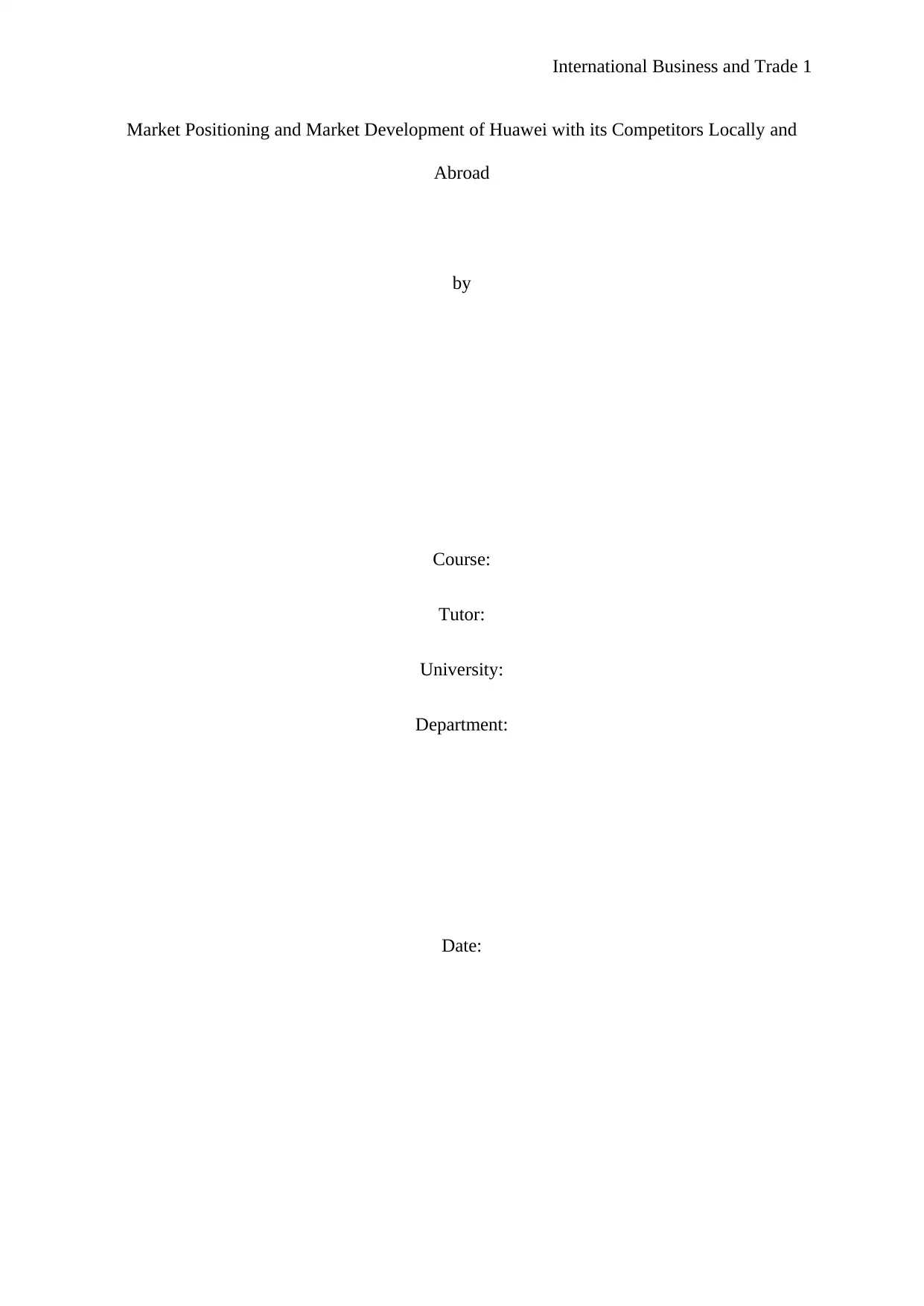
International Business and Trade 1
Market Positioning and Market Development of Huawei with its Competitors Locally and
Abroad
by
Course:
Tutor:
University:
Department:
Date:
Market Positioning and Market Development of Huawei with its Competitors Locally and
Abroad
by
Course:
Tutor:
University:
Department:
Date:
Paraphrase This Document
Need a fresh take? Get an instant paraphrase of this document with our AI Paraphraser
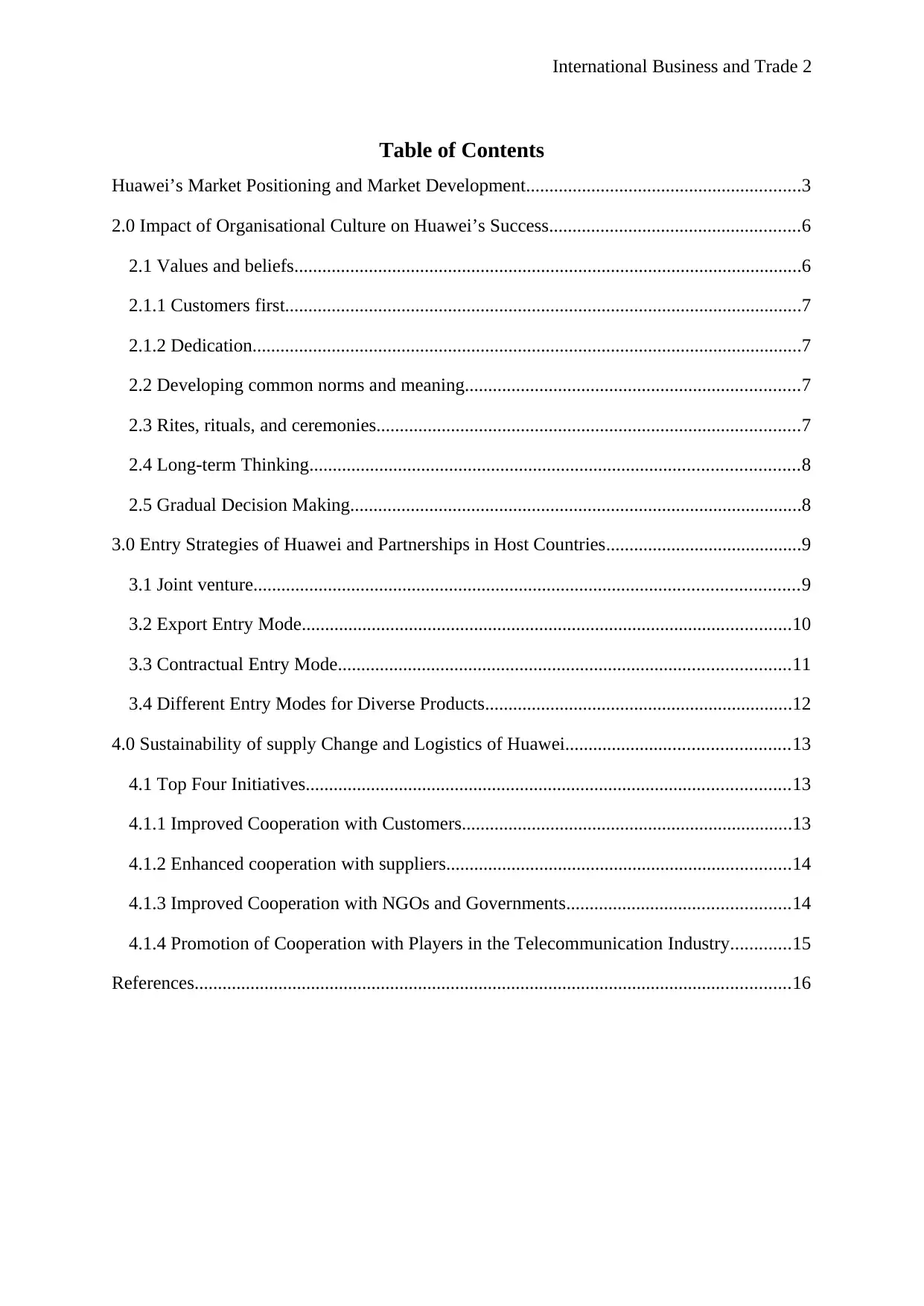
International Business and Trade 2
Table of Contents
Huawei’s Market Positioning and Market Development...........................................................3
2.0 Impact of Organisational Culture on Huawei’s Success......................................................6
2.1 Values and beliefs.............................................................................................................6
2.1.1 Customers first...............................................................................................................7
2.1.2 Dedication......................................................................................................................7
2.2 Developing common norms and meaning........................................................................7
2.3 Rites, rituals, and ceremonies...........................................................................................7
2.4 Long-term Thinking.........................................................................................................8
2.5 Gradual Decision Making.................................................................................................8
3.0 Entry Strategies of Huawei and Partnerships in Host Countries..........................................9
3.1 Joint venture.....................................................................................................................9
3.2 Export Entry Mode.........................................................................................................10
3.3 Contractual Entry Mode.................................................................................................11
3.4 Different Entry Modes for Diverse Products..................................................................12
4.0 Sustainability of supply Change and Logistics of Huawei................................................13
4.1 Top Four Initiatives........................................................................................................13
4.1.1 Improved Cooperation with Customers.......................................................................13
4.1.2 Enhanced cooperation with suppliers..........................................................................14
4.1.3 Improved Cooperation with NGOs and Governments................................................14
4.1.4 Promotion of Cooperation with Players in the Telecommunication Industry.............15
References................................................................................................................................16
Table of Contents
Huawei’s Market Positioning and Market Development...........................................................3
2.0 Impact of Organisational Culture on Huawei’s Success......................................................6
2.1 Values and beliefs.............................................................................................................6
2.1.1 Customers first...............................................................................................................7
2.1.2 Dedication......................................................................................................................7
2.2 Developing common norms and meaning........................................................................7
2.3 Rites, rituals, and ceremonies...........................................................................................7
2.4 Long-term Thinking.........................................................................................................8
2.5 Gradual Decision Making.................................................................................................8
3.0 Entry Strategies of Huawei and Partnerships in Host Countries..........................................9
3.1 Joint venture.....................................................................................................................9
3.2 Export Entry Mode.........................................................................................................10
3.3 Contractual Entry Mode.................................................................................................11
3.4 Different Entry Modes for Diverse Products..................................................................12
4.0 Sustainability of supply Change and Logistics of Huawei................................................13
4.1 Top Four Initiatives........................................................................................................13
4.1.1 Improved Cooperation with Customers.......................................................................13
4.1.2 Enhanced cooperation with suppliers..........................................................................14
4.1.3 Improved Cooperation with NGOs and Governments................................................14
4.1.4 Promotion of Cooperation with Players in the Telecommunication Industry.............15
References................................................................................................................................16
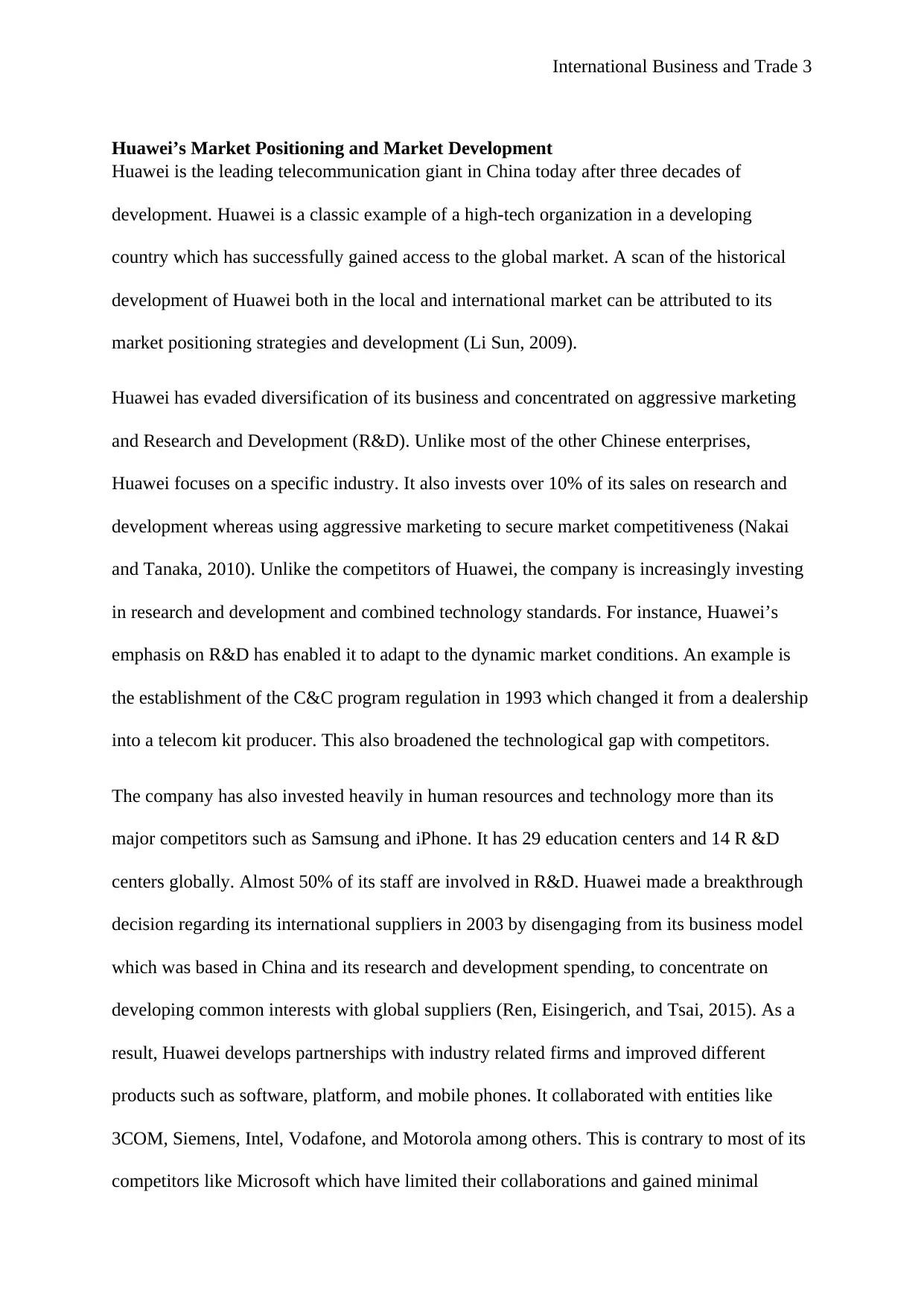
International Business and Trade 3
Huawei’s Market Positioning and Market Development
Huawei is the leading telecommunication giant in China today after three decades of
development. Huawei is a classic example of a high-tech organization in a developing
country which has successfully gained access to the global market. A scan of the historical
development of Huawei both in the local and international market can be attributed to its
market positioning strategies and development (Li Sun, 2009).
Huawei has evaded diversification of its business and concentrated on aggressive marketing
and Research and Development (R&D). Unlike most of the other Chinese enterprises,
Huawei focuses on a specific industry. It also invests over 10% of its sales on research and
development whereas using aggressive marketing to secure market competitiveness (Nakai
and Tanaka, 2010). Unlike the competitors of Huawei, the company is increasingly investing
in research and development and combined technology standards. For instance, Huawei’s
emphasis on R&D has enabled it to adapt to the dynamic market conditions. An example is
the establishment of the C&C program regulation in 1993 which changed it from a dealership
into a telecom kit producer. This also broadened the technological gap with competitors.
The company has also invested heavily in human resources and technology more than its
major competitors such as Samsung and iPhone. It has 29 education centers and 14 R &D
centers globally. Almost 50% of its staff are involved in R&D. Huawei made a breakthrough
decision regarding its international suppliers in 2003 by disengaging from its business model
which was based in China and its research and development spending, to concentrate on
developing common interests with global suppliers (Ren, Eisingerich, and Tsai, 2015). As a
result, Huawei develops partnerships with industry related firms and improved different
products such as software, platform, and mobile phones. It collaborated with entities like
3COM, Siemens, Intel, Vodafone, and Motorola among others. This is contrary to most of its
competitors like Microsoft which have limited their collaborations and gained minimal
Huawei’s Market Positioning and Market Development
Huawei is the leading telecommunication giant in China today after three decades of
development. Huawei is a classic example of a high-tech organization in a developing
country which has successfully gained access to the global market. A scan of the historical
development of Huawei both in the local and international market can be attributed to its
market positioning strategies and development (Li Sun, 2009).
Huawei has evaded diversification of its business and concentrated on aggressive marketing
and Research and Development (R&D). Unlike most of the other Chinese enterprises,
Huawei focuses on a specific industry. It also invests over 10% of its sales on research and
development whereas using aggressive marketing to secure market competitiveness (Nakai
and Tanaka, 2010). Unlike the competitors of Huawei, the company is increasingly investing
in research and development and combined technology standards. For instance, Huawei’s
emphasis on R&D has enabled it to adapt to the dynamic market conditions. An example is
the establishment of the C&C program regulation in 1993 which changed it from a dealership
into a telecom kit producer. This also broadened the technological gap with competitors.
The company has also invested heavily in human resources and technology more than its
major competitors such as Samsung and iPhone. It has 29 education centers and 14 R &D
centers globally. Almost 50% of its staff are involved in R&D. Huawei made a breakthrough
decision regarding its international suppliers in 2003 by disengaging from its business model
which was based in China and its research and development spending, to concentrate on
developing common interests with global suppliers (Ren, Eisingerich, and Tsai, 2015). As a
result, Huawei develops partnerships with industry related firms and improved different
products such as software, platform, and mobile phones. It collaborated with entities like
3COM, Siemens, Intel, Vodafone, and Motorola among others. This is contrary to most of its
competitors like Microsoft which have limited their collaborations and gained minimal
⊘ This is a preview!⊘
Do you want full access?
Subscribe today to unlock all pages.

Trusted by 1+ million students worldwide
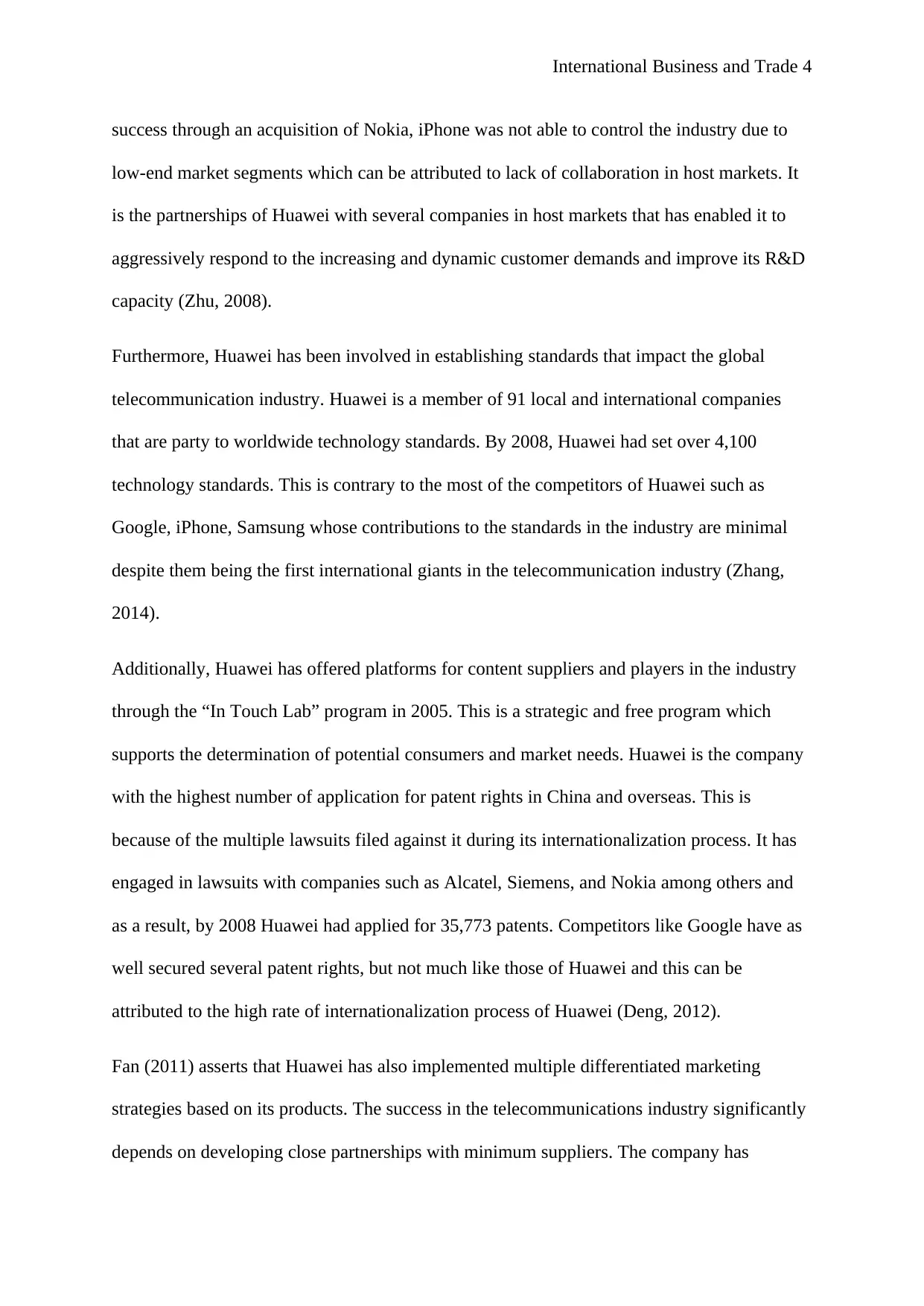
International Business and Trade 4
success through an acquisition of Nokia, iPhone was not able to control the industry due to
low-end market segments which can be attributed to lack of collaboration in host markets. It
is the partnerships of Huawei with several companies in host markets that has enabled it to
aggressively respond to the increasing and dynamic customer demands and improve its R&D
capacity (Zhu, 2008).
Furthermore, Huawei has been involved in establishing standards that impact the global
telecommunication industry. Huawei is a member of 91 local and international companies
that are party to worldwide technology standards. By 2008, Huawei had set over 4,100
technology standards. This is contrary to the most of the competitors of Huawei such as
Google, iPhone, Samsung whose contributions to the standards in the industry are minimal
despite them being the first international giants in the telecommunication industry (Zhang,
2014).
Additionally, Huawei has offered platforms for content suppliers and players in the industry
through the “In Touch Lab” program in 2005. This is a strategic and free program which
supports the determination of potential consumers and market needs. Huawei is the company
with the highest number of application for patent rights in China and overseas. This is
because of the multiple lawsuits filed against it during its internationalization process. It has
engaged in lawsuits with companies such as Alcatel, Siemens, and Nokia among others and
as a result, by 2008 Huawei had applied for 35,773 patents. Competitors like Google have as
well secured several patent rights, but not much like those of Huawei and this can be
attributed to the high rate of internationalization process of Huawei (Deng, 2012).
Fan (2011) asserts that Huawei has also implemented multiple differentiated marketing
strategies based on its products. The success in the telecommunications industry significantly
depends on developing close partnerships with minimum suppliers. The company has
success through an acquisition of Nokia, iPhone was not able to control the industry due to
low-end market segments which can be attributed to lack of collaboration in host markets. It
is the partnerships of Huawei with several companies in host markets that has enabled it to
aggressively respond to the increasing and dynamic customer demands and improve its R&D
capacity (Zhu, 2008).
Furthermore, Huawei has been involved in establishing standards that impact the global
telecommunication industry. Huawei is a member of 91 local and international companies
that are party to worldwide technology standards. By 2008, Huawei had set over 4,100
technology standards. This is contrary to the most of the competitors of Huawei such as
Google, iPhone, Samsung whose contributions to the standards in the industry are minimal
despite them being the first international giants in the telecommunication industry (Zhang,
2014).
Additionally, Huawei has offered platforms for content suppliers and players in the industry
through the “In Touch Lab” program in 2005. This is a strategic and free program which
supports the determination of potential consumers and market needs. Huawei is the company
with the highest number of application for patent rights in China and overseas. This is
because of the multiple lawsuits filed against it during its internationalization process. It has
engaged in lawsuits with companies such as Alcatel, Siemens, and Nokia among others and
as a result, by 2008 Huawei had applied for 35,773 patents. Competitors like Google have as
well secured several patent rights, but not much like those of Huawei and this can be
attributed to the high rate of internationalization process of Huawei (Deng, 2012).
Fan (2011) asserts that Huawei has also implemented multiple differentiated marketing
strategies based on its products. The success in the telecommunications industry significantly
depends on developing close partnerships with minimum suppliers. The company has
Paraphrase This Document
Need a fresh take? Get an instant paraphrase of this document with our AI Paraphraser
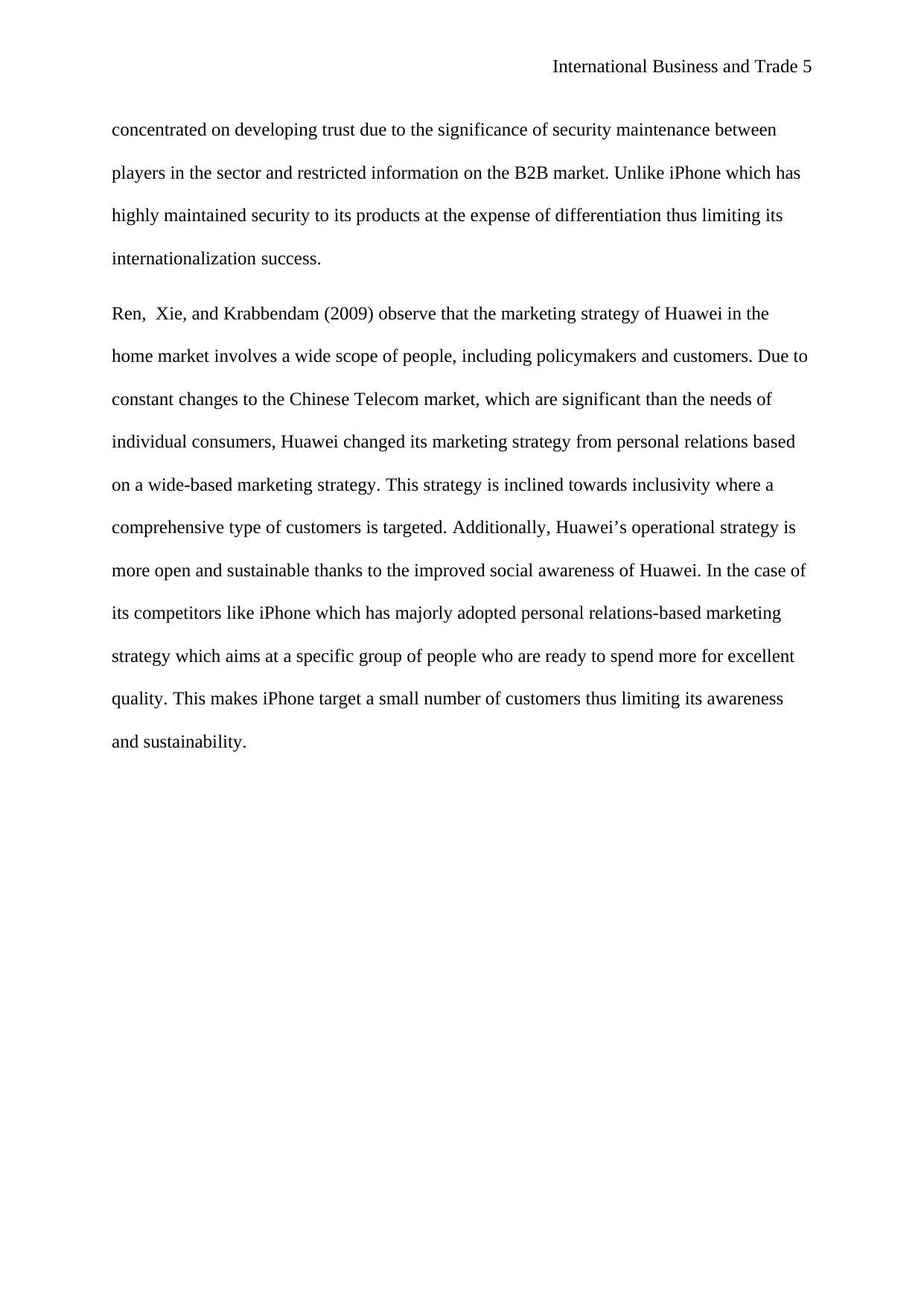
International Business and Trade 5
concentrated on developing trust due to the significance of security maintenance between
players in the sector and restricted information on the B2B market. Unlike iPhone which has
highly maintained security to its products at the expense of differentiation thus limiting its
internationalization success.
Ren, Xie, and Krabbendam (2009) observe that the marketing strategy of Huawei in the
home market involves a wide scope of people, including policymakers and customers. Due to
constant changes to the Chinese Telecom market, which are significant than the needs of
individual consumers, Huawei changed its marketing strategy from personal relations based
on a wide-based marketing strategy. This strategy is inclined towards inclusivity where a
comprehensive type of customers is targeted. Additionally, Huawei’s operational strategy is
more open and sustainable thanks to the improved social awareness of Huawei. In the case of
its competitors like iPhone which has majorly adopted personal relations-based marketing
strategy which aims at a specific group of people who are ready to spend more for excellent
quality. This makes iPhone target a small number of customers thus limiting its awareness
and sustainability.
concentrated on developing trust due to the significance of security maintenance between
players in the sector and restricted information on the B2B market. Unlike iPhone which has
highly maintained security to its products at the expense of differentiation thus limiting its
internationalization success.
Ren, Xie, and Krabbendam (2009) observe that the marketing strategy of Huawei in the
home market involves a wide scope of people, including policymakers and customers. Due to
constant changes to the Chinese Telecom market, which are significant than the needs of
individual consumers, Huawei changed its marketing strategy from personal relations based
on a wide-based marketing strategy. This strategy is inclined towards inclusivity where a
comprehensive type of customers is targeted. Additionally, Huawei’s operational strategy is
more open and sustainable thanks to the improved social awareness of Huawei. In the case of
its competitors like iPhone which has majorly adopted personal relations-based marketing
strategy which aims at a specific group of people who are ready to spend more for excellent
quality. This makes iPhone target a small number of customers thus limiting its awareness
and sustainability.
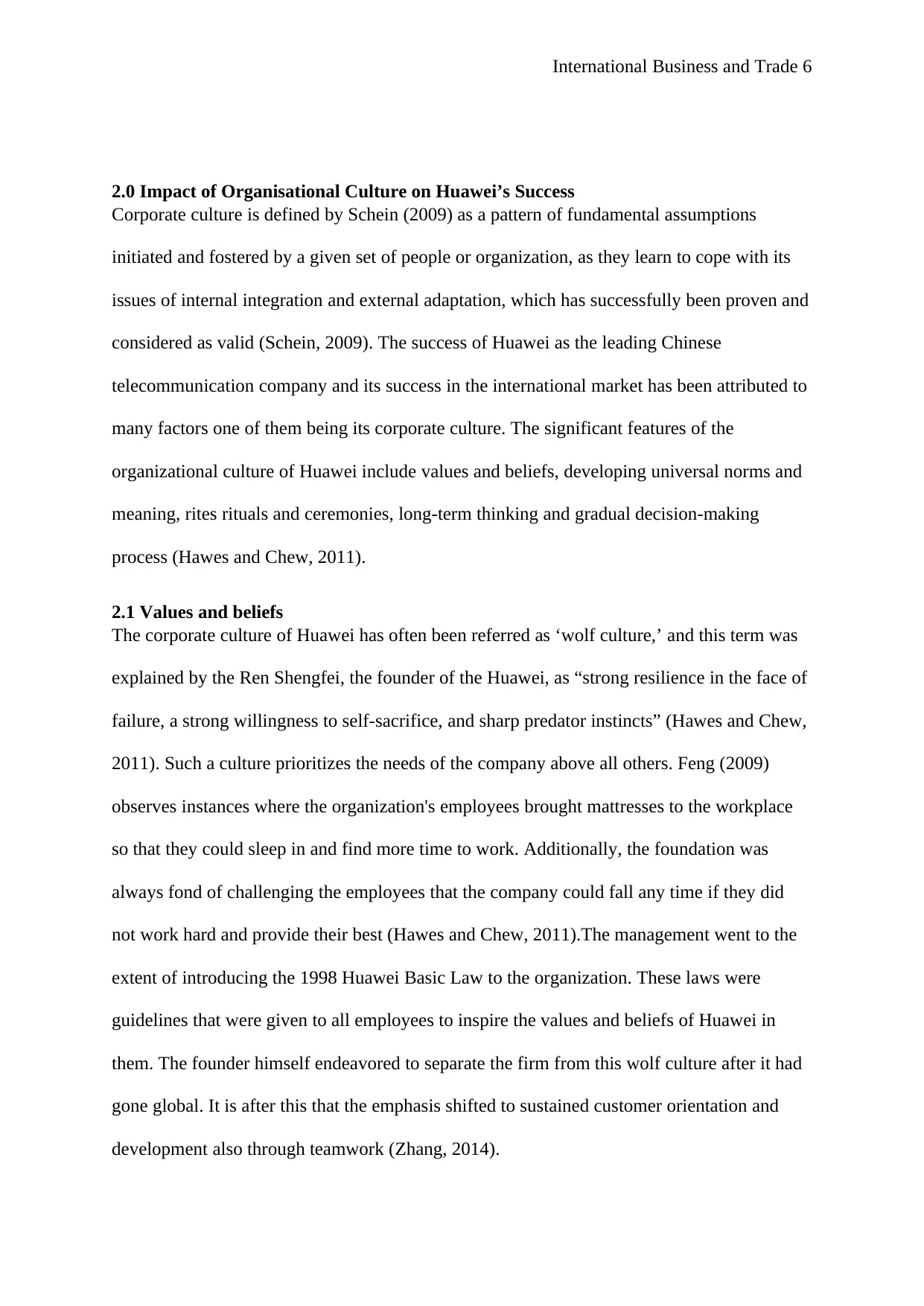
International Business and Trade 6
2.0 Impact of Organisational Culture on Huawei’s Success
Corporate culture is defined by Schein (2009) as a pattern of fundamental assumptions
initiated and fostered by a given set of people or organization, as they learn to cope with its
issues of internal integration and external adaptation, which has successfully been proven and
considered as valid (Schein, 2009). The success of Huawei as the leading Chinese
telecommunication company and its success in the international market has been attributed to
many factors one of them being its corporate culture. The significant features of the
organizational culture of Huawei include values and beliefs, developing universal norms and
meaning, rites rituals and ceremonies, long-term thinking and gradual decision-making
process (Hawes and Chew, 2011).
2.1 Values and beliefs
The corporate culture of Huawei has often been referred as ‘wolf culture,’ and this term was
explained by the Ren Shengfei, the founder of the Huawei, as “strong resilience in the face of
failure, a strong willingness to self-sacrifice, and sharp predator instincts” (Hawes and Chew,
2011). Such a culture prioritizes the needs of the company above all others. Feng (2009)
observes instances where the organization's employees brought mattresses to the workplace
so that they could sleep in and find more time to work. Additionally, the foundation was
always fond of challenging the employees that the company could fall any time if they did
not work hard and provide their best (Hawes and Chew, 2011).The management went to the
extent of introducing the 1998 Huawei Basic Law to the organization. These laws were
guidelines that were given to all employees to inspire the values and beliefs of Huawei in
them. The founder himself endeavored to separate the firm from this wolf culture after it had
gone global. It is after this that the emphasis shifted to sustained customer orientation and
development also through teamwork (Zhang, 2014).
2.0 Impact of Organisational Culture on Huawei’s Success
Corporate culture is defined by Schein (2009) as a pattern of fundamental assumptions
initiated and fostered by a given set of people or organization, as they learn to cope with its
issues of internal integration and external adaptation, which has successfully been proven and
considered as valid (Schein, 2009). The success of Huawei as the leading Chinese
telecommunication company and its success in the international market has been attributed to
many factors one of them being its corporate culture. The significant features of the
organizational culture of Huawei include values and beliefs, developing universal norms and
meaning, rites rituals and ceremonies, long-term thinking and gradual decision-making
process (Hawes and Chew, 2011).
2.1 Values and beliefs
The corporate culture of Huawei has often been referred as ‘wolf culture,’ and this term was
explained by the Ren Shengfei, the founder of the Huawei, as “strong resilience in the face of
failure, a strong willingness to self-sacrifice, and sharp predator instincts” (Hawes and Chew,
2011). Such a culture prioritizes the needs of the company above all others. Feng (2009)
observes instances where the organization's employees brought mattresses to the workplace
so that they could sleep in and find more time to work. Additionally, the foundation was
always fond of challenging the employees that the company could fall any time if they did
not work hard and provide their best (Hawes and Chew, 2011).The management went to the
extent of introducing the 1998 Huawei Basic Law to the organization. These laws were
guidelines that were given to all employees to inspire the values and beliefs of Huawei in
them. The founder himself endeavored to separate the firm from this wolf culture after it had
gone global. It is after this that the emphasis shifted to sustained customer orientation and
development also through teamwork (Zhang, 2014).
⊘ This is a preview!⊘
Do you want full access?
Subscribe today to unlock all pages.

Trusted by 1+ million students worldwide
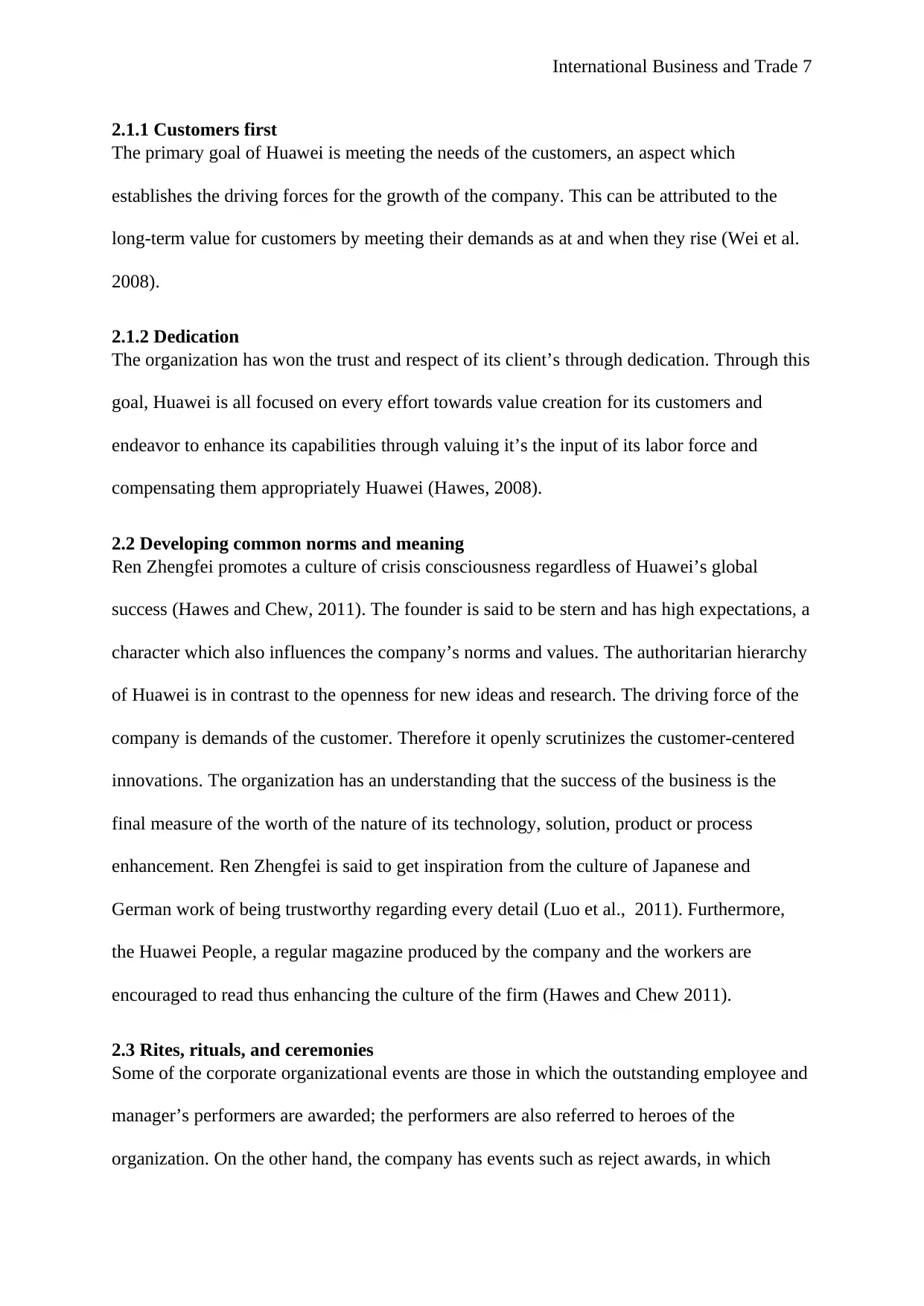
International Business and Trade 7
2.1.1 Customers first
The primary goal of Huawei is meeting the needs of the customers, an aspect which
establishes the driving forces for the growth of the company. This can be attributed to the
long-term value for customers by meeting their demands as at and when they rise (Wei et al.
2008).
2.1.2 Dedication
The organization has won the trust and respect of its client’s through dedication. Through this
goal, Huawei is all focused on every effort towards value creation for its customers and
endeavor to enhance its capabilities through valuing it’s the input of its labor force and
compensating them appropriately Huawei (Hawes, 2008).
2.2 Developing common norms and meaning
Ren Zhengfei promotes a culture of crisis consciousness regardless of Huawei’s global
success (Hawes and Chew, 2011). The founder is said to be stern and has high expectations, a
character which also influences the company’s norms and values. The authoritarian hierarchy
of Huawei is in contrast to the openness for new ideas and research. The driving force of the
company is demands of the customer. Therefore it openly scrutinizes the customer-centered
innovations. The organization has an understanding that the success of the business is the
final measure of the worth of the nature of its technology, solution, product or process
enhancement. Ren Zhengfei is said to get inspiration from the culture of Japanese and
German work of being trustworthy regarding every detail (Luo et al., 2011). Furthermore,
the Huawei People, a regular magazine produced by the company and the workers are
encouraged to read thus enhancing the culture of the firm (Hawes and Chew 2011).
2.3 Rites, rituals, and ceremonies
Some of the corporate organizational events are those in which the outstanding employee and
manager’s performers are awarded; the performers are also referred to heroes of the
organization. On the other hand, the company has events such as reject awards, in which
2.1.1 Customers first
The primary goal of Huawei is meeting the needs of the customers, an aspect which
establishes the driving forces for the growth of the company. This can be attributed to the
long-term value for customers by meeting their demands as at and when they rise (Wei et al.
2008).
2.1.2 Dedication
The organization has won the trust and respect of its client’s through dedication. Through this
goal, Huawei is all focused on every effort towards value creation for its customers and
endeavor to enhance its capabilities through valuing it’s the input of its labor force and
compensating them appropriately Huawei (Hawes, 2008).
2.2 Developing common norms and meaning
Ren Zhengfei promotes a culture of crisis consciousness regardless of Huawei’s global
success (Hawes and Chew, 2011). The founder is said to be stern and has high expectations, a
character which also influences the company’s norms and values. The authoritarian hierarchy
of Huawei is in contrast to the openness for new ideas and research. The driving force of the
company is demands of the customer. Therefore it openly scrutinizes the customer-centered
innovations. The organization has an understanding that the success of the business is the
final measure of the worth of the nature of its technology, solution, product or process
enhancement. Ren Zhengfei is said to get inspiration from the culture of Japanese and
German work of being trustworthy regarding every detail (Luo et al., 2011). Furthermore,
the Huawei People, a regular magazine produced by the company and the workers are
encouraged to read thus enhancing the culture of the firm (Hawes and Chew 2011).
2.3 Rites, rituals, and ceremonies
Some of the corporate organizational events are those in which the outstanding employee and
manager’s performers are awarded; the performers are also referred to heroes of the
organization. On the other hand, the company has events such as reject awards, in which
Paraphrase This Document
Need a fresh take? Get an instant paraphrase of this document with our AI Paraphraser
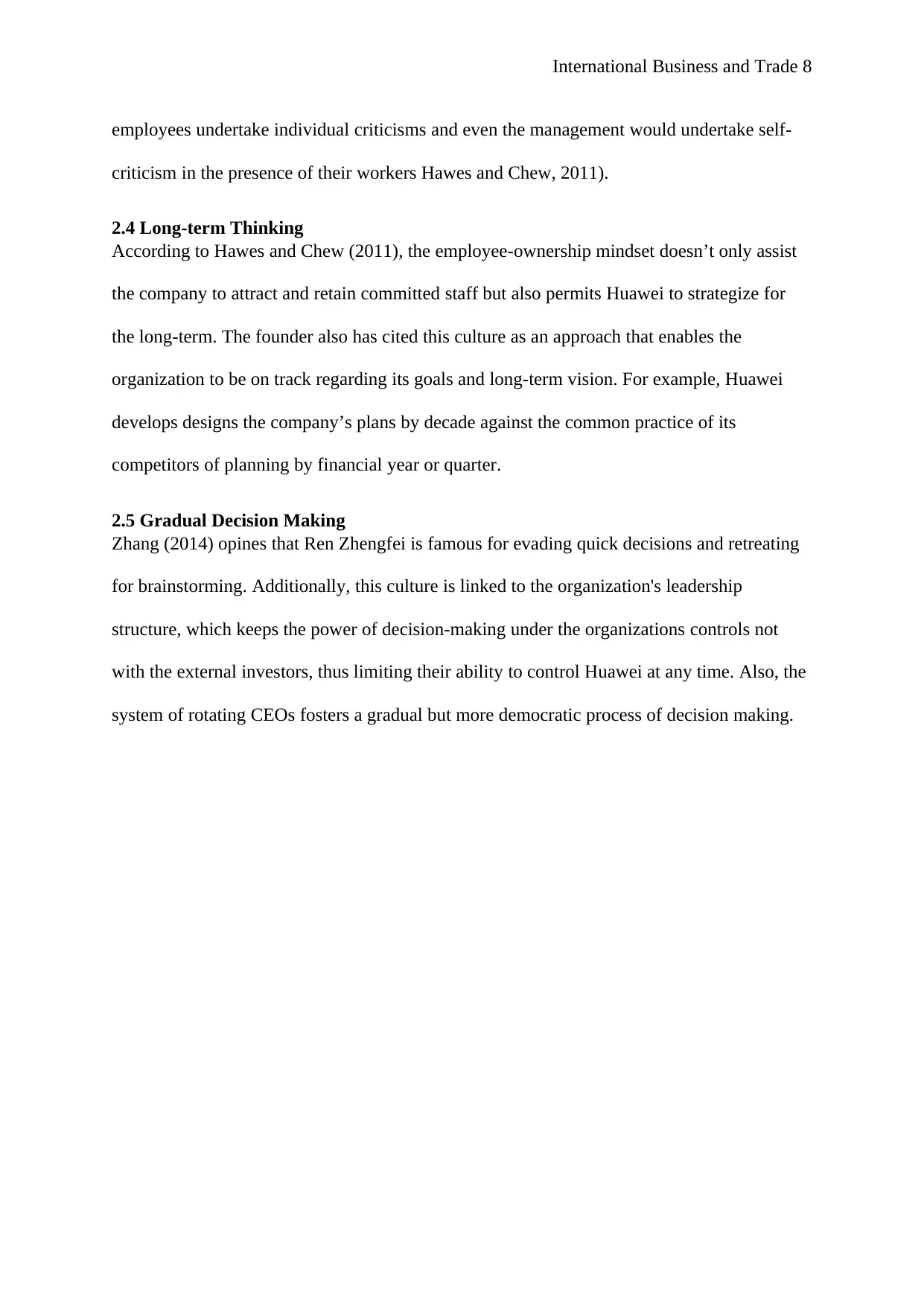
International Business and Trade 8
employees undertake individual criticisms and even the management would undertake self-
criticism in the presence of their workers Hawes and Chew, 2011).
2.4 Long-term Thinking
According to Hawes and Chew (2011), the employee-ownership mindset doesn’t only assist
the company to attract and retain committed staff but also permits Huawei to strategize for
the long-term. The founder also has cited this culture as an approach that enables the
organization to be on track regarding its goals and long-term vision. For example, Huawei
develops designs the company’s plans by decade against the common practice of its
competitors of planning by financial year or quarter.
2.5 Gradual Decision Making
Zhang (2014) opines that Ren Zhengfei is famous for evading quick decisions and retreating
for brainstorming. Additionally, this culture is linked to the organization's leadership
structure, which keeps the power of decision-making under the organizations controls not
with the external investors, thus limiting their ability to control Huawei at any time. Also, the
system of rotating CEOs fosters a gradual but more democratic process of decision making.
employees undertake individual criticisms and even the management would undertake self-
criticism in the presence of their workers Hawes and Chew, 2011).
2.4 Long-term Thinking
According to Hawes and Chew (2011), the employee-ownership mindset doesn’t only assist
the company to attract and retain committed staff but also permits Huawei to strategize for
the long-term. The founder also has cited this culture as an approach that enables the
organization to be on track regarding its goals and long-term vision. For example, Huawei
develops designs the company’s plans by decade against the common practice of its
competitors of planning by financial year or quarter.
2.5 Gradual Decision Making
Zhang (2014) opines that Ren Zhengfei is famous for evading quick decisions and retreating
for brainstorming. Additionally, this culture is linked to the organization's leadership
structure, which keeps the power of decision-making under the organizations controls not
with the external investors, thus limiting their ability to control Huawei at any time. Also, the
system of rotating CEOs fosters a gradual but more democratic process of decision making.
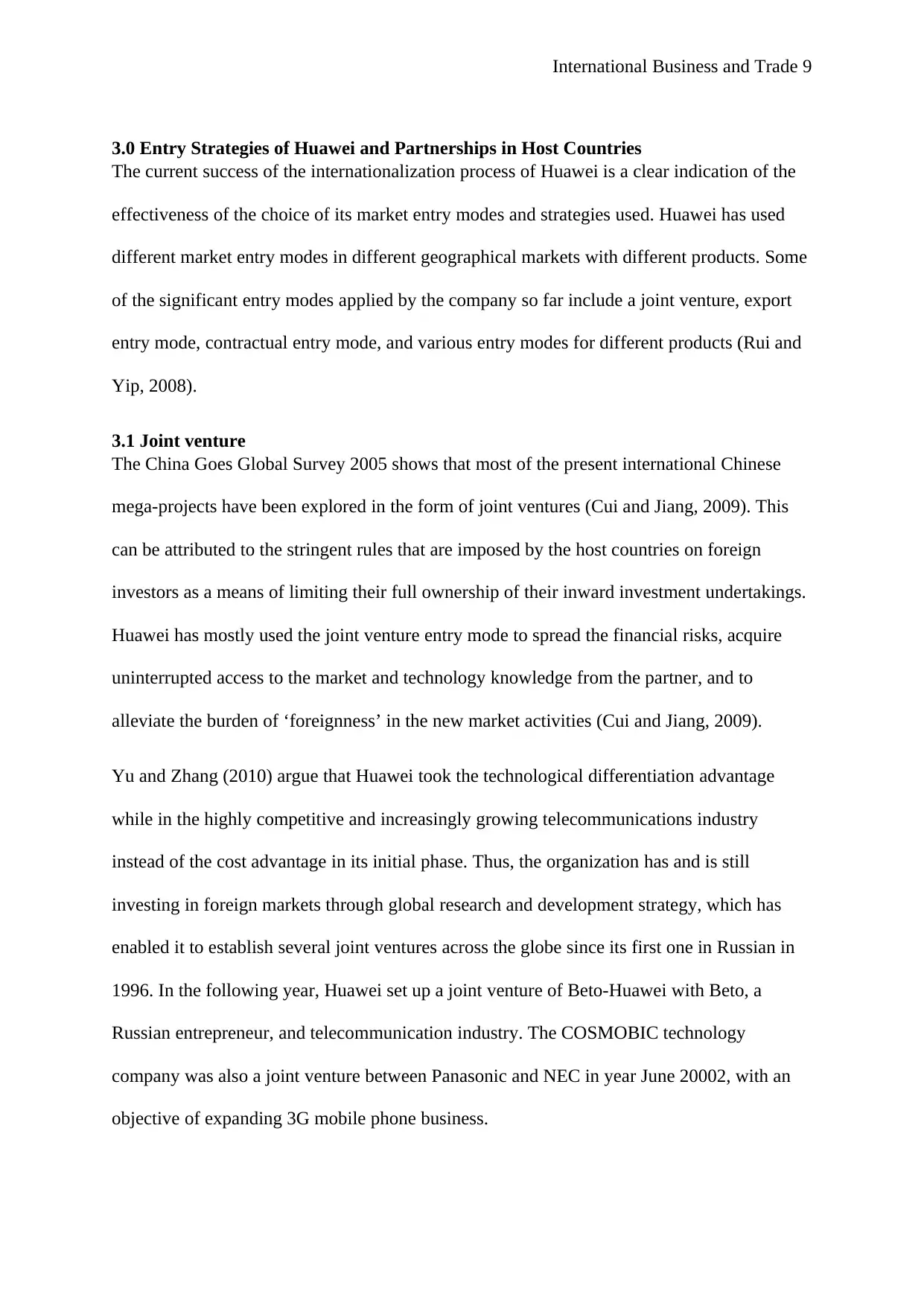
International Business and Trade 9
3.0 Entry Strategies of Huawei and Partnerships in Host Countries
The current success of the internationalization process of Huawei is a clear indication of the
effectiveness of the choice of its market entry modes and strategies used. Huawei has used
different market entry modes in different geographical markets with different products. Some
of the significant entry modes applied by the company so far include a joint venture, export
entry mode, contractual entry mode, and various entry modes for different products (Rui and
Yip, 2008).
3.1 Joint venture
The China Goes Global Survey 2005 shows that most of the present international Chinese
mega-projects have been explored in the form of joint ventures (Cui and Jiang, 2009). This
can be attributed to the stringent rules that are imposed by the host countries on foreign
investors as a means of limiting their full ownership of their inward investment undertakings.
Huawei has mostly used the joint venture entry mode to spread the financial risks, acquire
uninterrupted access to the market and technology knowledge from the partner, and to
alleviate the burden of ‘foreignness’ in the new market activities (Cui and Jiang, 2009).
Yu and Zhang (2010) argue that Huawei took the technological differentiation advantage
while in the highly competitive and increasingly growing telecommunications industry
instead of the cost advantage in its initial phase. Thus, the organization has and is still
investing in foreign markets through global research and development strategy, which has
enabled it to establish several joint ventures across the globe since its first one in Russian in
1996. In the following year, Huawei set up a joint venture of Beto-Huawei with Beto, a
Russian entrepreneur, and telecommunication industry. The COSMOBIC technology
company was also a joint venture between Panasonic and NEC in year June 20002, with an
objective of expanding 3G mobile phone business.
3.0 Entry Strategies of Huawei and Partnerships in Host Countries
The current success of the internationalization process of Huawei is a clear indication of the
effectiveness of the choice of its market entry modes and strategies used. Huawei has used
different market entry modes in different geographical markets with different products. Some
of the significant entry modes applied by the company so far include a joint venture, export
entry mode, contractual entry mode, and various entry modes for different products (Rui and
Yip, 2008).
3.1 Joint venture
The China Goes Global Survey 2005 shows that most of the present international Chinese
mega-projects have been explored in the form of joint ventures (Cui and Jiang, 2009). This
can be attributed to the stringent rules that are imposed by the host countries on foreign
investors as a means of limiting their full ownership of their inward investment undertakings.
Huawei has mostly used the joint venture entry mode to spread the financial risks, acquire
uninterrupted access to the market and technology knowledge from the partner, and to
alleviate the burden of ‘foreignness’ in the new market activities (Cui and Jiang, 2009).
Yu and Zhang (2010) argue that Huawei took the technological differentiation advantage
while in the highly competitive and increasingly growing telecommunications industry
instead of the cost advantage in its initial phase. Thus, the organization has and is still
investing in foreign markets through global research and development strategy, which has
enabled it to establish several joint ventures across the globe since its first one in Russian in
1996. In the following year, Huawei set up a joint venture of Beto-Huawei with Beto, a
Russian entrepreneur, and telecommunication industry. The COSMOBIC technology
company was also a joint venture between Panasonic and NEC in year June 20002, with an
objective of expanding 3G mobile phone business.
⊘ This is a preview!⊘
Do you want full access?
Subscribe today to unlock all pages.

Trusted by 1+ million students worldwide
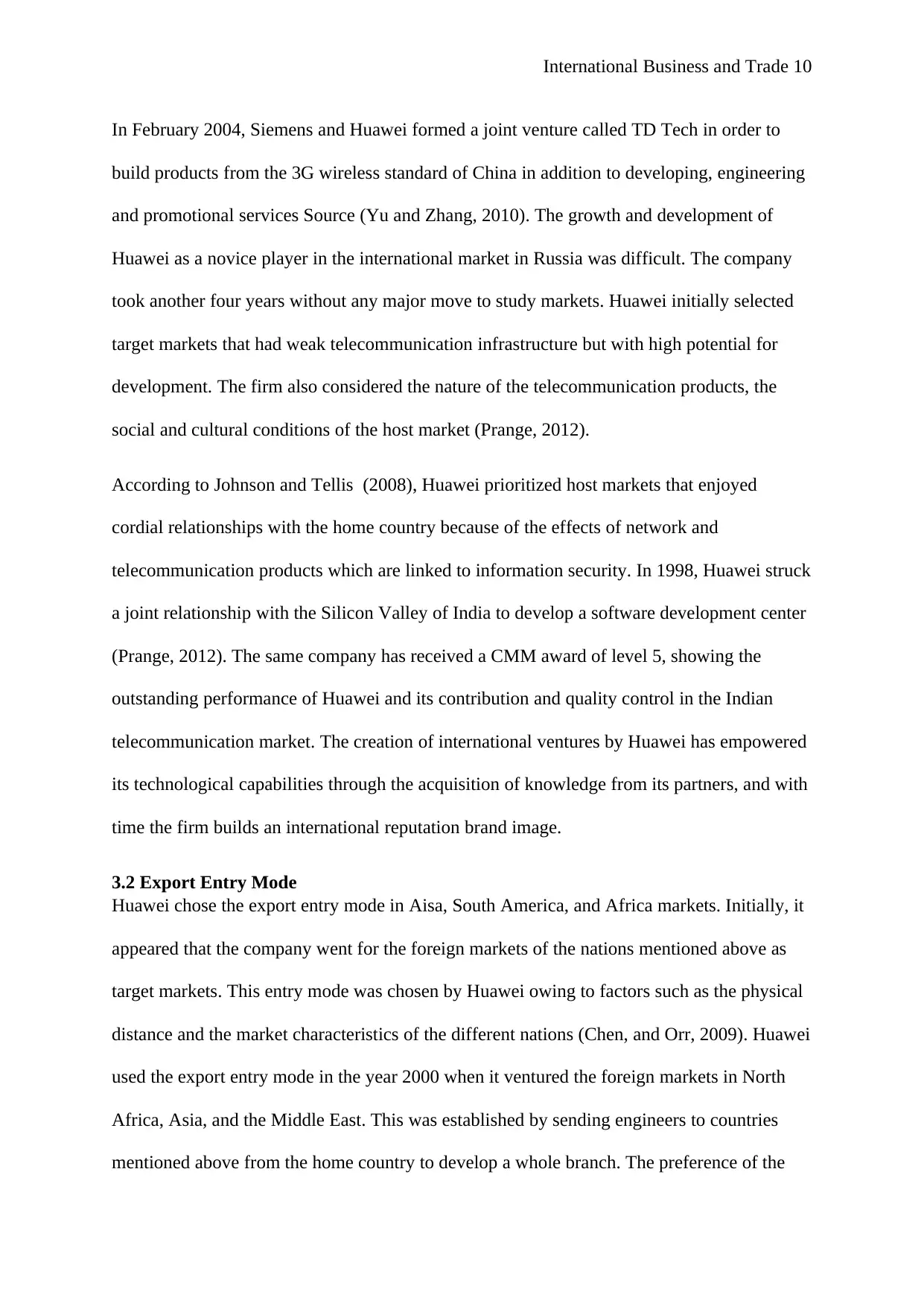
International Business and Trade 10
In February 2004, Siemens and Huawei formed a joint venture called TD Tech in order to
build products from the 3G wireless standard of China in addition to developing, engineering
and promotional services Source (Yu and Zhang, 2010). The growth and development of
Huawei as a novice player in the international market in Russia was difficult. The company
took another four years without any major move to study markets. Huawei initially selected
target markets that had weak telecommunication infrastructure but with high potential for
development. The firm also considered the nature of the telecommunication products, the
social and cultural conditions of the host market (Prange, 2012).
According to Johnson and Tellis (2008), Huawei prioritized host markets that enjoyed
cordial relationships with the home country because of the effects of network and
telecommunication products which are linked to information security. In 1998, Huawei struck
a joint relationship with the Silicon Valley of India to develop a software development center
(Prange, 2012). The same company has received a CMM award of level 5, showing the
outstanding performance of Huawei and its contribution and quality control in the Indian
telecommunication market. The creation of international ventures by Huawei has empowered
its technological capabilities through the acquisition of knowledge from its partners, and with
time the firm builds an international reputation brand image.
3.2 Export Entry Mode
Huawei chose the export entry mode in Aisa, South America, and Africa markets. Initially, it
appeared that the company went for the foreign markets of the nations mentioned above as
target markets. This entry mode was chosen by Huawei owing to factors such as the physical
distance and the market characteristics of the different nations (Chen, and Orr, 2009). Huawei
used the export entry mode in the year 2000 when it ventured the foreign markets in North
Africa, Asia, and the Middle East. This was established by sending engineers to countries
mentioned above from the home country to develop a whole branch. The preference of the
In February 2004, Siemens and Huawei formed a joint venture called TD Tech in order to
build products from the 3G wireless standard of China in addition to developing, engineering
and promotional services Source (Yu and Zhang, 2010). The growth and development of
Huawei as a novice player in the international market in Russia was difficult. The company
took another four years without any major move to study markets. Huawei initially selected
target markets that had weak telecommunication infrastructure but with high potential for
development. The firm also considered the nature of the telecommunication products, the
social and cultural conditions of the host market (Prange, 2012).
According to Johnson and Tellis (2008), Huawei prioritized host markets that enjoyed
cordial relationships with the home country because of the effects of network and
telecommunication products which are linked to information security. In 1998, Huawei struck
a joint relationship with the Silicon Valley of India to develop a software development center
(Prange, 2012). The same company has received a CMM award of level 5, showing the
outstanding performance of Huawei and its contribution and quality control in the Indian
telecommunication market. The creation of international ventures by Huawei has empowered
its technological capabilities through the acquisition of knowledge from its partners, and with
time the firm builds an international reputation brand image.
3.2 Export Entry Mode
Huawei chose the export entry mode in Aisa, South America, and Africa markets. Initially, it
appeared that the company went for the foreign markets of the nations mentioned above as
target markets. This entry mode was chosen by Huawei owing to factors such as the physical
distance and the market characteristics of the different nations (Chen, and Orr, 2009). Huawei
used the export entry mode in the year 2000 when it ventured the foreign markets in North
Africa, Asia, and the Middle East. This was established by sending engineers to countries
mentioned above from the home country to develop a whole branch. The preference of the
Paraphrase This Document
Need a fresh take? Get an instant paraphrase of this document with our AI Paraphraser
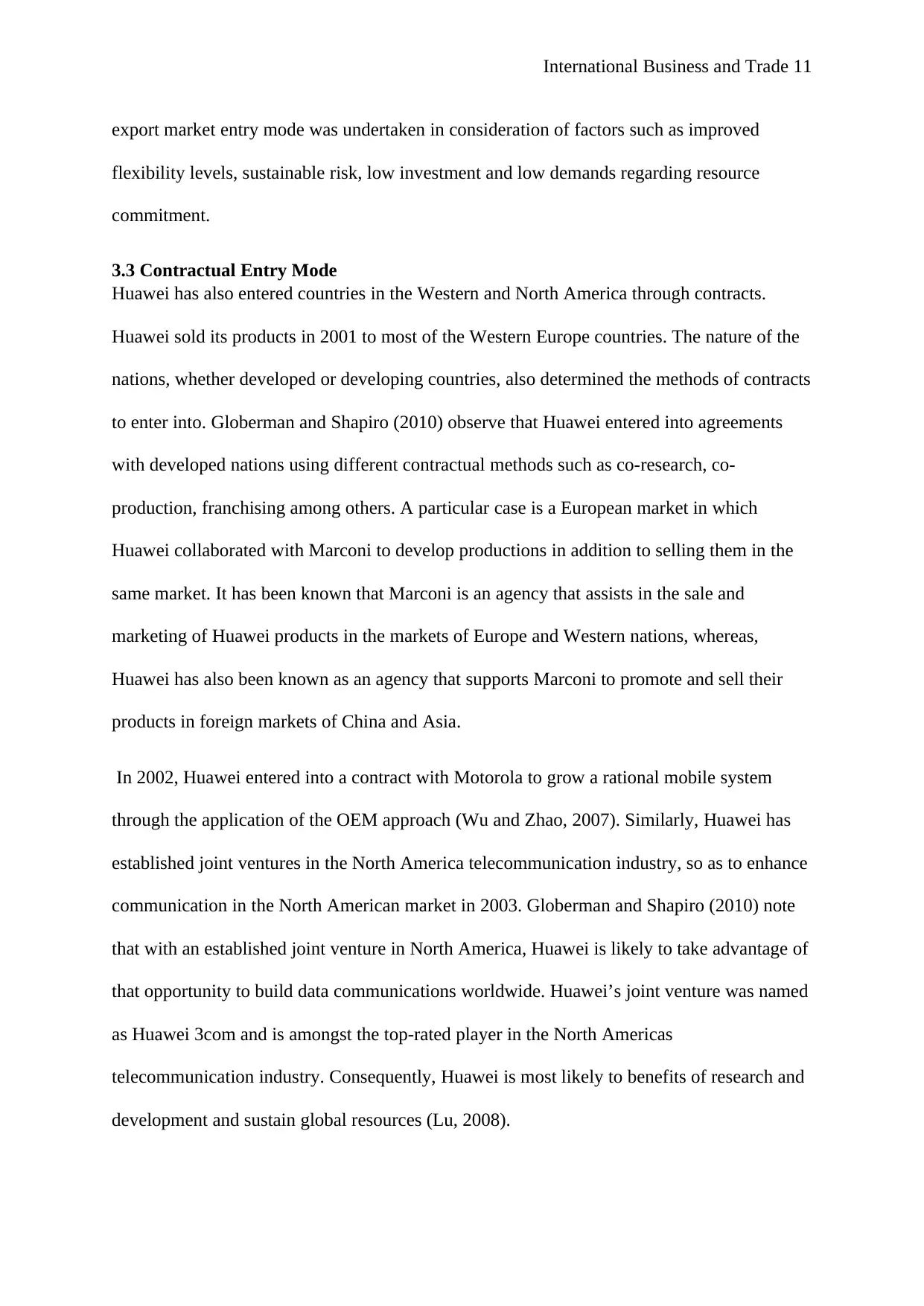
International Business and Trade 11
export market entry mode was undertaken in consideration of factors such as improved
flexibility levels, sustainable risk, low investment and low demands regarding resource
commitment.
3.3 Contractual Entry Mode
Huawei has also entered countries in the Western and North America through contracts.
Huawei sold its products in 2001 to most of the Western Europe countries. The nature of the
nations, whether developed or developing countries, also determined the methods of contracts
to enter into. Globerman and Shapiro (2010) observe that Huawei entered into agreements
with developed nations using different contractual methods such as co-research, co-
production, franchising among others. A particular case is a European market in which
Huawei collaborated with Marconi to develop productions in addition to selling them in the
same market. It has been known that Marconi is an agency that assists in the sale and
marketing of Huawei products in the markets of Europe and Western nations, whereas,
Huawei has also been known as an agency that supports Marconi to promote and sell their
products in foreign markets of China and Asia.
In 2002, Huawei entered into a contract with Motorola to grow a rational mobile system
through the application of the OEM approach (Wu and Zhao, 2007). Similarly, Huawei has
established joint ventures in the North America telecommunication industry, so as to enhance
communication in the North American market in 2003. Globerman and Shapiro (2010) note
that with an established joint venture in North America, Huawei is likely to take advantage of
that opportunity to build data communications worldwide. Huawei’s joint venture was named
as Huawei 3com and is amongst the top-rated player in the North Americas
telecommunication industry. Consequently, Huawei is most likely to benefits of research and
development and sustain global resources (Lu, 2008).
export market entry mode was undertaken in consideration of factors such as improved
flexibility levels, sustainable risk, low investment and low demands regarding resource
commitment.
3.3 Contractual Entry Mode
Huawei has also entered countries in the Western and North America through contracts.
Huawei sold its products in 2001 to most of the Western Europe countries. The nature of the
nations, whether developed or developing countries, also determined the methods of contracts
to enter into. Globerman and Shapiro (2010) observe that Huawei entered into agreements
with developed nations using different contractual methods such as co-research, co-
production, franchising among others. A particular case is a European market in which
Huawei collaborated with Marconi to develop productions in addition to selling them in the
same market. It has been known that Marconi is an agency that assists in the sale and
marketing of Huawei products in the markets of Europe and Western nations, whereas,
Huawei has also been known as an agency that supports Marconi to promote and sell their
products in foreign markets of China and Asia.
In 2002, Huawei entered into a contract with Motorola to grow a rational mobile system
through the application of the OEM approach (Wu and Zhao, 2007). Similarly, Huawei has
established joint ventures in the North America telecommunication industry, so as to enhance
communication in the North American market in 2003. Globerman and Shapiro (2010) note
that with an established joint venture in North America, Huawei is likely to take advantage of
that opportunity to build data communications worldwide. Huawei’s joint venture was named
as Huawei 3com and is amongst the top-rated player in the North Americas
telecommunication industry. Consequently, Huawei is most likely to benefits of research and
development and sustain global resources (Lu, 2008).
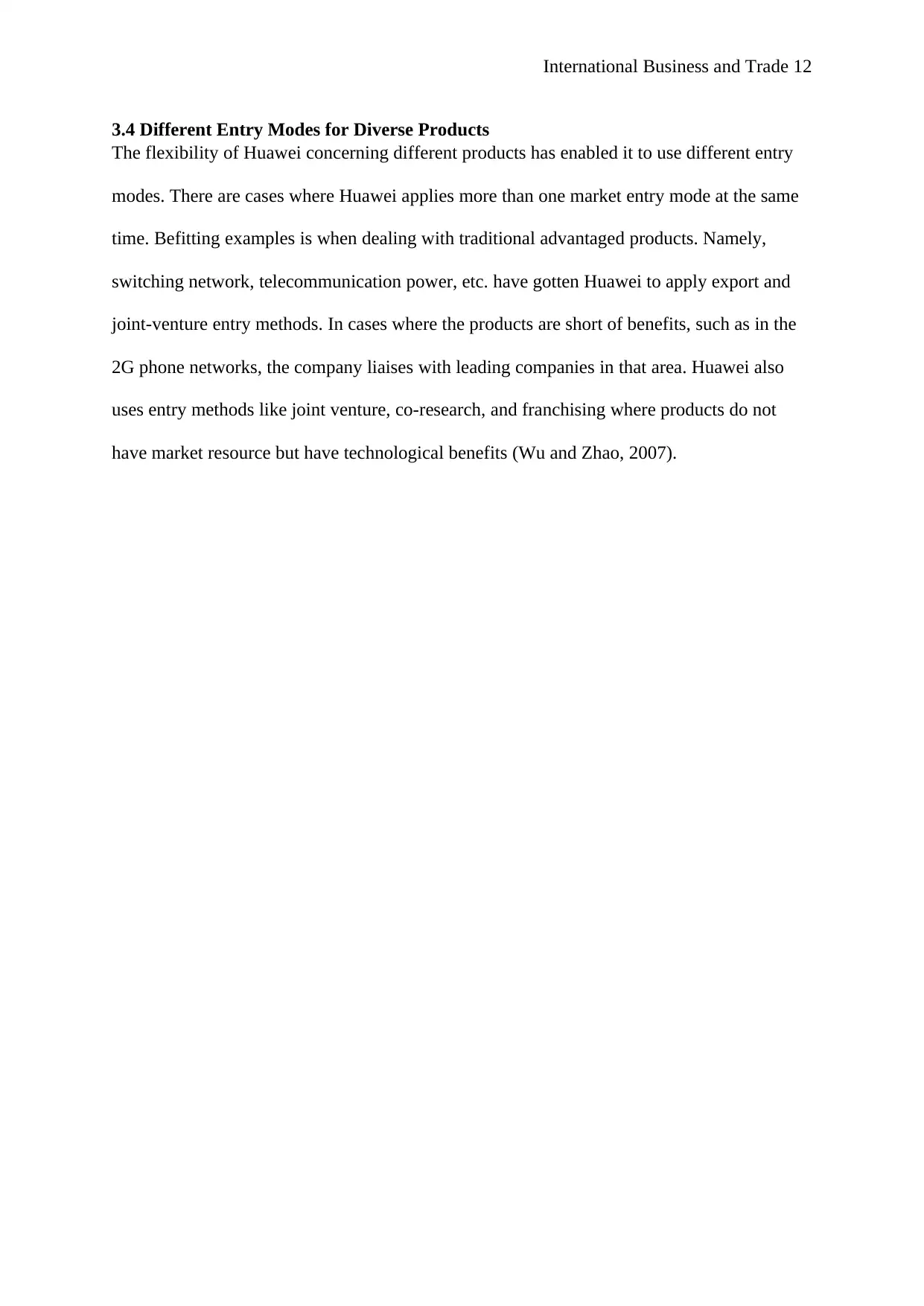
International Business and Trade 12
3.4 Different Entry Modes for Diverse Products
The flexibility of Huawei concerning different products has enabled it to use different entry
modes. There are cases where Huawei applies more than one market entry mode at the same
time. Befitting examples is when dealing with traditional advantaged products. Namely,
switching network, telecommunication power, etc. have gotten Huawei to apply export and
joint-venture entry methods. In cases where the products are short of benefits, such as in the
2G phone networks, the company liaises with leading companies in that area. Huawei also
uses entry methods like joint venture, co-research, and franchising where products do not
have market resource but have technological benefits (Wu and Zhao, 2007).
3.4 Different Entry Modes for Diverse Products
The flexibility of Huawei concerning different products has enabled it to use different entry
modes. There are cases where Huawei applies more than one market entry mode at the same
time. Befitting examples is when dealing with traditional advantaged products. Namely,
switching network, telecommunication power, etc. have gotten Huawei to apply export and
joint-venture entry methods. In cases where the products are short of benefits, such as in the
2G phone networks, the company liaises with leading companies in that area. Huawei also
uses entry methods like joint venture, co-research, and franchising where products do not
have market resource but have technological benefits (Wu and Zhao, 2007).
⊘ This is a preview!⊘
Do you want full access?
Subscribe today to unlock all pages.

Trusted by 1+ million students worldwide
1 out of 19
Related Documents
Your All-in-One AI-Powered Toolkit for Academic Success.
+13062052269
info@desklib.com
Available 24*7 on WhatsApp / Email
![[object Object]](/_next/static/media/star-bottom.7253800d.svg)
Unlock your academic potential
Copyright © 2020–2025 A2Z Services. All Rights Reserved. Developed and managed by ZUCOL.





